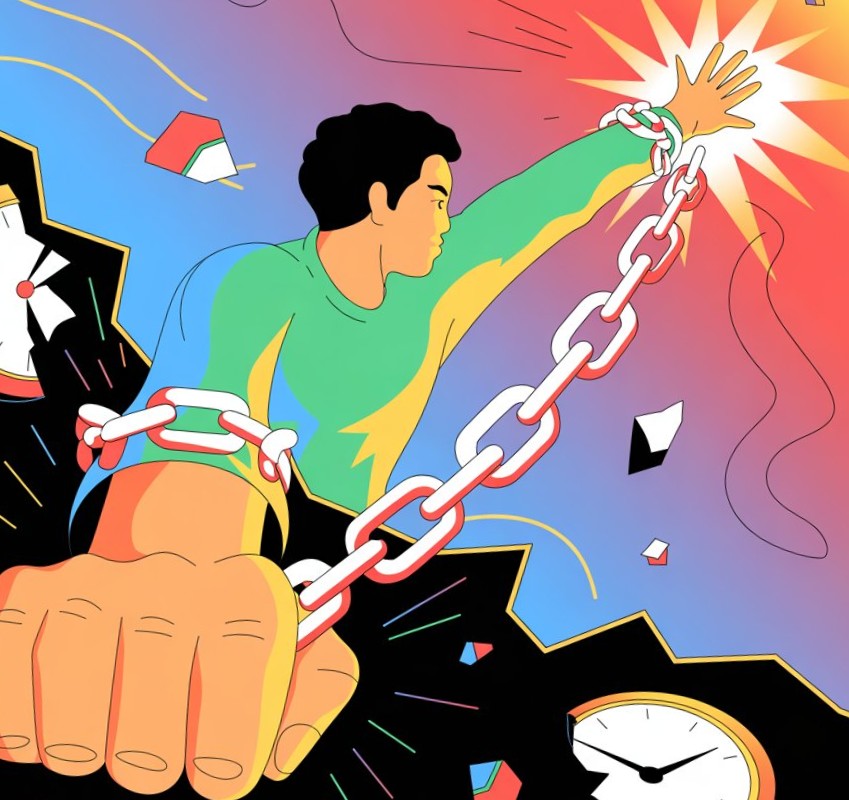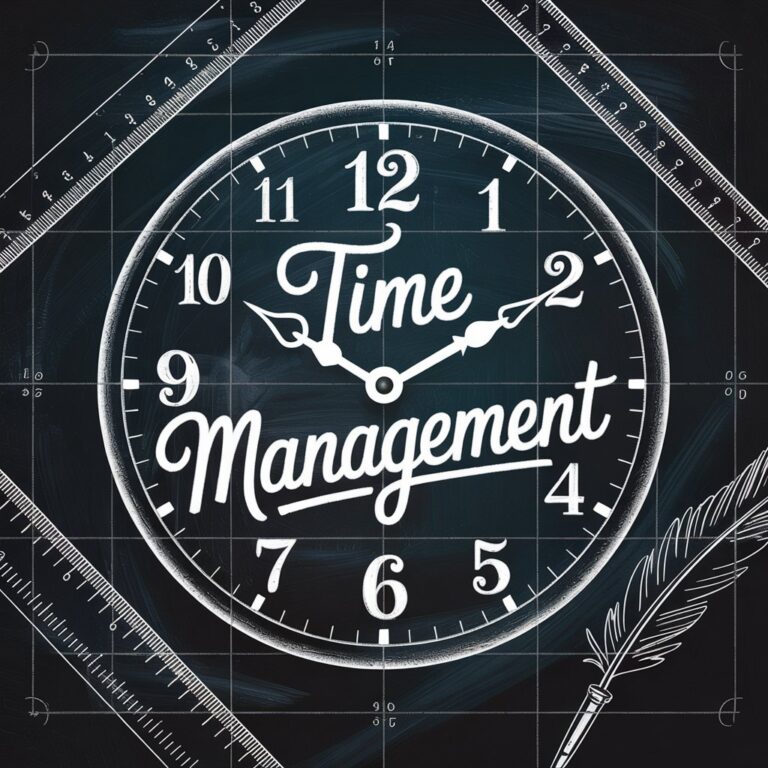How to Shatter Procrastination Habits with 5 Game-Changing Tricks

Let me be completely honest here, MOST OF US HAVE EXPERIENCED PROCRASTINATION.
Actually, correction, EVERYBODY has experienced some degree of procrastination.
Especially in high school, with mounds of homework and the never ending stress, it’s quite easy to put off certain things.
Maybe you crammed for a test last minute or you tried to finish up a week long project on the day before it was due (definitely NOT me), we’ve all been there at some point.
Once you are an adolescent, it starts becoming less forgiving to procrastinate. There’s more at stake, and a LOT more pressure.
To make sure you don’t fail your next test, here are 5 easy tricks you can incorporate into your schedule.
With these tips, you’ll be sure to break out of that endless loop and start locking in!
Focus your Energy on 1-2 Tasks a Day

One of the best ways to streamline your workload is to reduce the amount of tasks. Instead of trying to do everything faster, focus your time on completing one task first. You want to do a good job on one task rather than spreading yourself thin.
There are many ways to implement this strategy. One of them is to create a calendar.
Creating a calendar comes with many benefits, not only to break procrastination, but can also boost productivity and improve time management.
Calendars also allow you to plan your schedule ahead of time.
Every decision we make drains our energy. If we wake up each day without giving thought to what we’re going to do on that day, we’re just going to be wasting a large portion of our energy thinking about our next steps.
- Should I hit the gym today, or go tomorrow?
- Should I study for my test now, or after dinner?
- Should I wear this or wear that? Eat this or eat that? Reply now or later?
The list just goes on and on. With each question we ask ourselves, we need an answer. This compels us to make decisions – lowering our self-control and making us tired. Consequently, this leads to procrastination as we can’t find a meaningful task to work on.

The biggest improvement you can make in your life is to streamline the decision-making process. How?
USE A CALENDAR!
This allows you to plan your days ahead of time to know what you want to focus on for the day. The key is to reduce the number of decisions you have to make during a given day.
By planning those decisions ahead of time, you are giving your body time to prepare for what’s to come next. This builds good habits around certain areas of your life to boost your effectiveness and prevent you from draining your energy by thinking about whether to do them or not.
Here are some examples:
Some examples:
- Decide in advance exactly which days of the week you’ll exercise, instead of deciding the day of;
- Pick out your clothes the night before rather than the morning of;
- Study for the subject you’re the weakest in, and schedule a time to do it;
This also goes hand in hand with setting attainable goals and effectively time-blocking activities. Combining these skills together, you can focus on the important activities in your life rather than procrastinating on them by doing the meaningless stuff.
Build off of the Previous Day

Adding onto the previous trick, begin planning for the next day on the day before. At night, before you go to bed, try to visualize what your going to be doing. You might not follow it exactly but it gives you a general idea of the most important task that should be completed.
Rather than frantically figuring out what to do on a given day, its best to jot some notes down on what you think should be completed the next day. I like to think of it as mapping out your expedition before the day you set sail.
For example:
- My Most IMPORTANT Thing (MIT) that needs to be done by the end of the day. This task has no exceptions and is the one thing that HAS to be completed.
- My Non-Daily Essentials (NDE) are small side activities that could enrich my life, but aren’t as important at the current moment. This could be hanging out with friends, or playing video games.
Do Something or Do Nothing
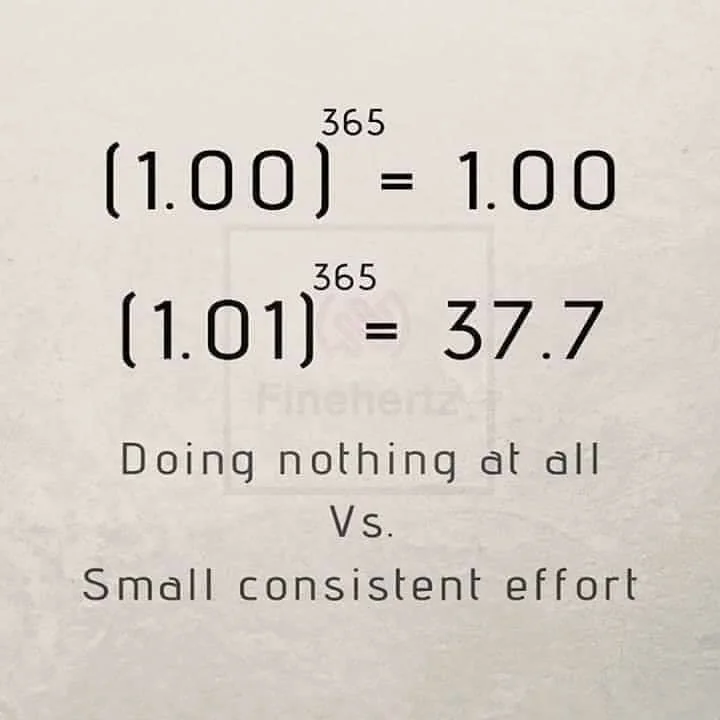
Raymond Chandler, the legendary crime-fiction novelist, battled procrastination just like many of us. Instead of forcing himself to meet a strict word count every day, he created a rule that helped him stay disciplined without burning out. His solution? “The Nothing Alternative.”
Every morning, Chandler would dedicate four hours solely to writing — with one condition: he could either write or do absolutely nothing. No reading, no cleaning, no checking the mail. Just writing… or staring out the window. As he put it, “He doesn’t have to write, and if he doesn’t feel like it, he shouldn’t try… but he is not to do any other positive thing.”
This simple yet powerful mindset removed all distractions and made writing the most appealing option. Chandler’s “write or nothing” approach turned procrastination into productivity — on his own terms.
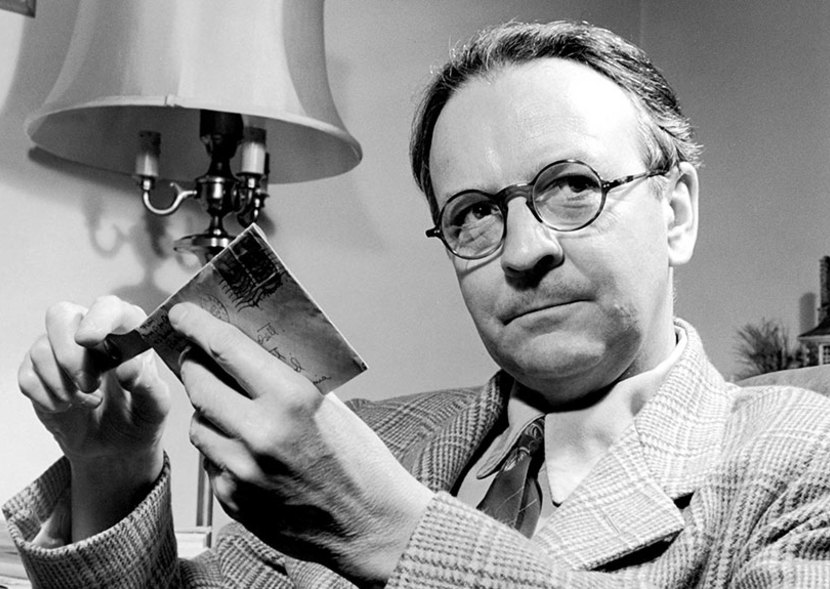
The rules are pretty easy to memorize:
- A) You don’t have to write or work on whatever you need to work on.
- B) But you can’t do anything else.
I know this kind of goes against my previous points about actually doing meaningful work. However, sometimes, we can all get stuck. Maybe you had a rough day and really didn’t have time to plan your schedule.
Well, no problem! With these two options, you’re bound to have something to do. You’re going to eventually start working, even if its just busy work. What do you know, maybe it might actually help relieve stress and keep you occupied for some time.
The task might not be as defined as Chandler’s is, but the key here to remember is: Do nothing, or focus on the ONE important thing.
Try this out for yourself. Set aside some time to work on a task using this method. Try to limit distractions and have a fully uninterrupted session.
Eliminate All Distractions
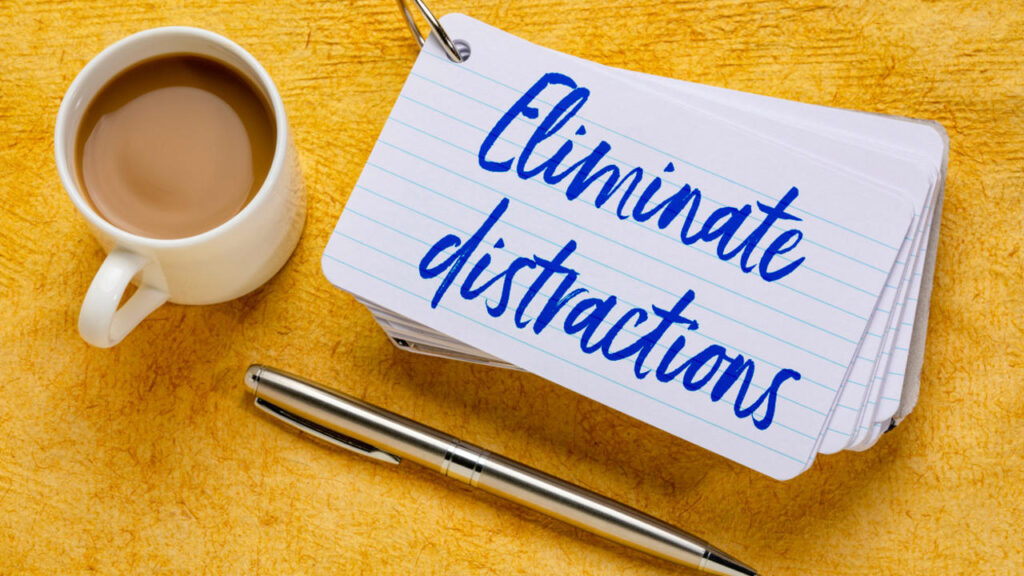
If you’re a gambling addict, don’t stay around the casino. You also shouldn’t hang out with people who like to throw away their life savings for a chance at the lottery.
Likewise, make sure you remove EVERYTHING that will even distract you in the slightest. Whether that be an electronic device, food, or even a person, please find a way to focus.
If you can’t handle public spaces, move somewhere private. Go somewhere that doesn’t have any cues that will trigger a distraction and prevent you from completing your MIT (Most Important Goal).
In my case, I like listening to classical music while I work. So normally, I would use my phone and play some music through my AirPods. At least for me, I think the soothing melodies improve my concentration and help me work productively.
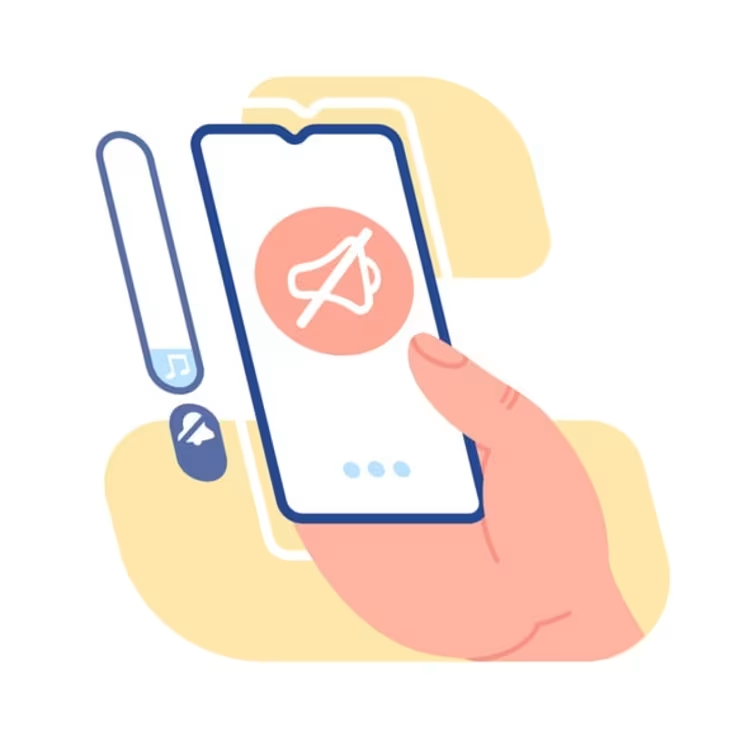
On the other hand, if you absolutely cannot control your device usage, I suggest keeping it out of your sight. Quite literally, take it out of your room or working space until you’re done. You need to avoid any possible distractions and stay productive during the time block. You planned this time to study, so you should respect that and hold yourself accountable.
I’ve seen some people turn off notifications for their phone or turn on the “Do not Disturb” feature, but I find that ineffective. These days, it becomes very difficult to control the urge to reach for your phone. Even the slightest screen change can cause you to reach out and satisfy that urge.
My advice? Don’t do it. Don’t even put it in the drawer or under your pillow. Remove it from the premises. Forget about it. You need to make sure you LOCK IN for this session.
For those of you who wear apple watches, take those off. Since those sync to your phone, anytime something happens on your phone, it will ping your watch too. It’s literally right on your wrist, so you will most definitely check it if you don’t take it off.
Essentially, you need to unplug before you can plug in and start working.
Use the V.I.B.E Technique
This is a strategy that I developed myself during my time in high school. I found that many procrastination tips were too generalized and didn’t fit my needs specifically.
I then created my own set of tricks that could help me focus during study sessions. I’ve decided to share this strategy with you guys. Hopefully, you’ll start incorporating this technique into your daily routine as well!
And don’t forget to share this with your friends and family too!
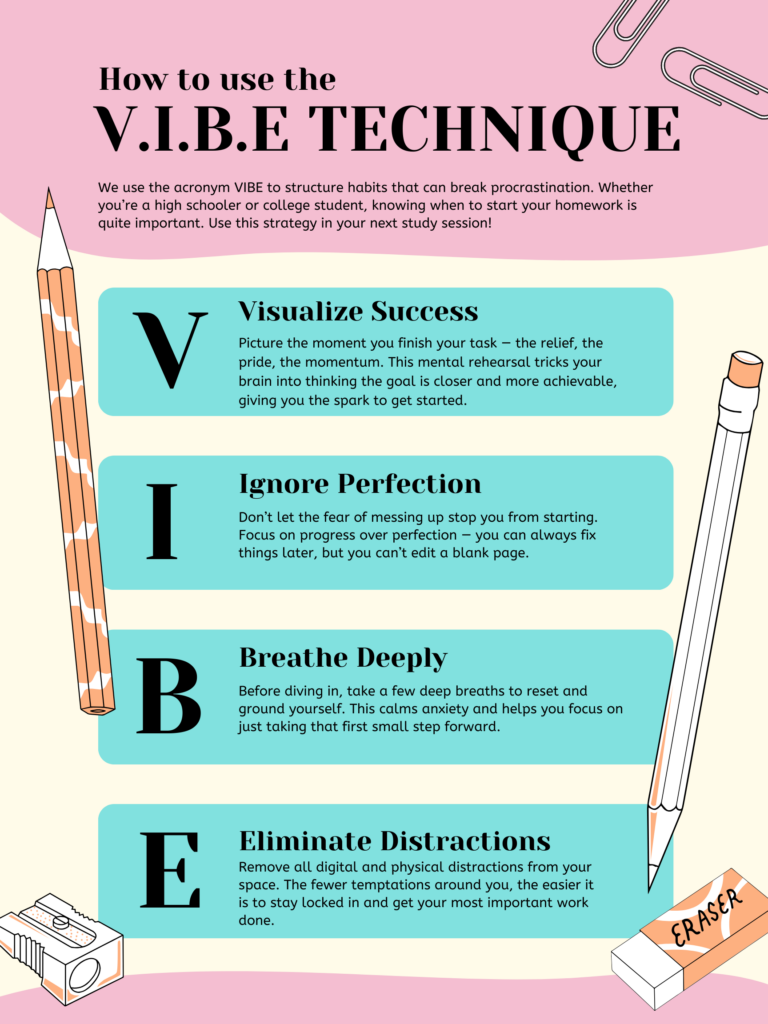
V – Visualize Success

I find that visualizing the finished product and that emotional relief helps motivate me. On some days, I might feel very overwhelmed and just need that small push to get me started.
When I sit at my desk, I visualize what my end goal is like and I use that vision to motivate me through my study session. That emotional reward really does help, I’m serious, even if the actual result itself isn’t that impressive.
On days where it’s just really sluggish, trust me, this technique really comes in handy.
It doesn’t have to be that complicated either. Taking just 30 seconds to mentally rehearse the task’s completion — and feeling the satisfaction, relief, or momentum that follows — can trick your brain into believing it’s more achievable.
🧘 Tip: Close your eyes and picture yourself crossing off the task, turning it in, or sharing the result with pride. Let that emotional reward drive you forward.
I – Ignore Perfection

As high school students, we all know the intense stress that happens on a daily basis. There might be so much to do in one day that just thinking about them overwhelms your mind.
Well, I’ve been there many times. And when this happens, you end up doing nothing because you spend the whole time sulking about the long pile of work ahead. This obviously isn’t good so I decided to change it up a bit.
Instead of perfecting a task, complete it first.
Procrastination often masks perfectionism. You put things off not because you’re lazy, but because you’re afraid it won’t turn out perfect.
The truth? Done is better than perfect.
Start messy. Allow yourself to do a “bad” first draft. Productivity is born from momentum, not flawless execution.
Stop stressing about the final product the minute you start working on something, take the time to plan out a rough outline first. Afterwards, then dive in and start fixing the details. This gives your brain a warm-up before the real competition, building a strong foundation.
🎨 Tip: Set a 10-minute timer and tell yourself, “I’m just going to do the ugly version first.”
B – Breathe Deeply

I know this sounds cliche, but this is a method that has stood the test of time.
Starting is the hardest part of working. Once you start, resistance fades. Deep breathing interrupts the anxiety spiral and shifts you into the present moment.
You don’t need to do everything. You just need to start.
🔑 Tip: Take 3 deep belly breaths, exhale slowly, and then take the first micro-action — like opening a document or writing the title.
Make sure you clear your mind of anything that is not related to the task you are about to start. Start fresh and prepare yourself. Rise to the challenge.
You got this!
E – End Distractions

This is essentially a repeat of what I said before, but I want to make this point VERY clear.
You might think that you can get away with your phone somewhere in the vicinity, but NO.
It will tempt you like the devil, and you will eventually fall into its trap. Trust me, keep it away from you. Don’t have it near you or within the same building parameters as you.
You’ll thank me later.
Just as a review:
Your brain can’t focus when it’s being pinged, buzzed, and tempted by dopamine-heavy distractions.
Clear your digital space → Close extra tabs.
Clear your physical space → Tidy your desk.
Clear your mental space → Write down intrusive thoughts to revisit later.
🚫 Tip: Try the “One Tab Rule”, keeping only one tab open at a time to prevent distractions by jumping to other websites. Switching between tabs makes you lose focus and become less productive.
Final Thoughts: You Can Beat Procrastination
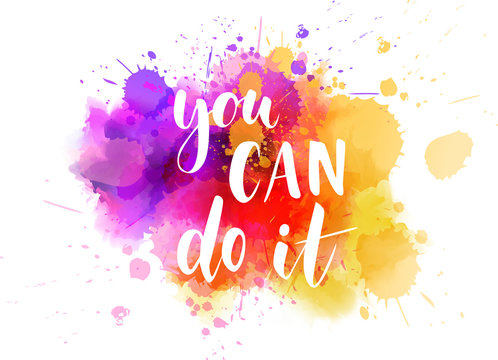
Procrastination isn’t a personal failure — it’s a habit. And like all habits, it can be changed. Whether you’re dealing with a tough week at school, struggling to get started on a project, or simply feeling stuck in a cycle of delay, the tools are now in your hands.
From focusing your energy and building momentum day-by-day, to mastering your distractions and channeling your inner V.I.B.E., you have multiple strategies to break free from the trap of procrastination.
Remember: progress doesn’t have to be perfect. Even small, consistent changes will snowball over time. Start by applying just one of these tricks today — even something as simple as visualizing success or writing down tomorrow’s most important task.
The best version of you is just on the other side of action. So go ahead — take a breath, shake off the doubt, and lock in.

